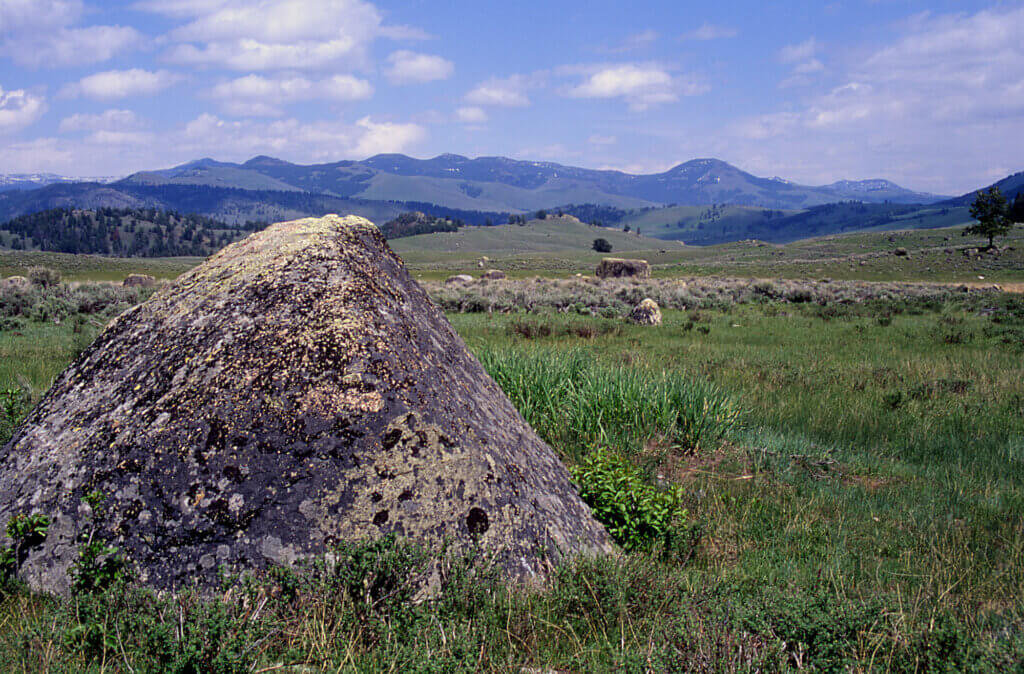Nurse Rocks: Shaping Montana’s Ecosystem For 10,000 Years
By Tom Torma
Broadcast 9.2012, 6.2015, and 9.27 & 9.30.2023

Ground moraines & glacial erratics near Junction Butte, Yellowstone National Park. Photo by Jo Suderman, public domain.
Listen:
Few sights have the romantic appeal of a lone tree growing in the grasslands of Montana. While these trees are beloved by photographers and artists for the serenity and peace they evoke, their origins typically lie in a more abrasive past.
As the Wisconsian and Pinedale glaciations began their slow march from the mountains of western Montana and greater Yellowstone, they picked up rocks of varying size—from pebbles to house-sized boulders. When the climate shifted and the glaciers melted, the rocks trapped in the ice settled on the ground and became known as glacial erratics.
These erratics create microclimates that serve a number of important ecological functions. The turbulence created by the rough surface of the rocks helps melt the area around the rock, and brings warmer spring air to the colder areas beneath the snow. Indeed, it is not uncommon to see a melted patch of snow surrounding large rocks and boulders during the spring melt. This gives the area surrounding the boulder a longer growing season, which fosters some of the first green shoots of the year, which in turn helps ease the transition for animals that have been feeding off brown, desiccated grass all winter.
In addition to supporting grasses, these rocks also support trees. In a study of trees and bushes reaching over a half a meter on the harsh southern exposures of Glacier National Park, 63 percent were found beside boulders. These rocks are named “nurse rocks” because, in addition to lengthening the growing season, they help to hold moisture, provide limited shade, trap seeds and give them time to root, and shelter saplings from the extreme winds that buffet much of the state.
It is not only rocks that provide suitable microhabitats for trees. Human-created debris, animal bones, and even other plants can serve a similar function. However, trees that grow in Montana’s harshest environments often have a rock at their base. This is especially true of the saplings on dry southern exposures and the windblown plains and valley floors of our state.
The erratics that serve as nurse rocks are most often found in the areas once covered by the relatively recent Wisconsian and Pinedale glaciations. Of course, the effects of those now-melted glaciers go beyond just the trees. The rocks support the trees, which in turn support a variety of other life forms. Often nurse rocks support saplings at the edges of forests—between places where trees can easily grow in abundance and the harsher environments where, even with the support of glacial erratics, they cannot grow. This loose scattering of trees increases the boundary zones between the two habitats—and increases the biodiversity of the surrounding area.
Even the lone tree, so beloved by poets and photographers, plays an important ecological role. Insects live in its bark and branches; birds use it to perch, feed and nest; and larger animals find shade beneath its leaves.
Although the erratics were simply dropped down when the glaciers melted, they are not a passive part of Montana’s scenery. As human-caused climate change advances, some native tree species might make a last stand where they can find supportive microhabitats created by the rocks. And others might push into areas where their seeds find nurse rocks to bring them up.
Regardless of what does happen, glacial erratics have been shaping Montana’s ecosystems for the past 10,000 or so years—and they will likely continue to do so for the foreseeable future.
Every week since 1991, Field Notes has inquired about Montana’s natural history. Field Notes are written by naturalists, students, and listeners about the puzzle-tree bark, eagle talons, woolly aphids, and giant puffballs of Western, Central and Southwestern Montana and aired weekly on Montana Public Radio.
Click here to read and listen to more Field Notes. Field Notes is available as a podcast! Subscribe on Apple Podcasts or wherever you listen to podcasts.
Interested in writing a Field Note? Contact Allison De Jong, Field Notes editor, at adejong [at] montananaturalist [dot] org or 406.327.0405.
Want to learn more about our programs as well as fun natural history facts and seasonal phenology? Sign up for our e-newsletter! You can also become a member and get discounts on our programs as well as free reciprocal admission to 300+ science centers in North America!












